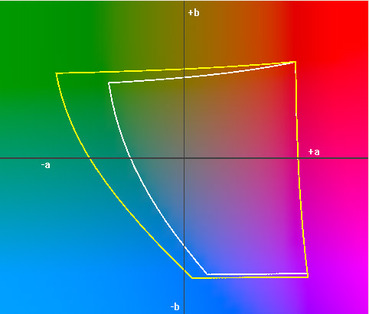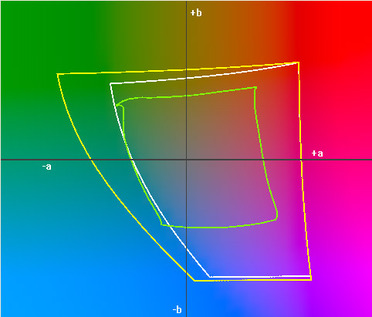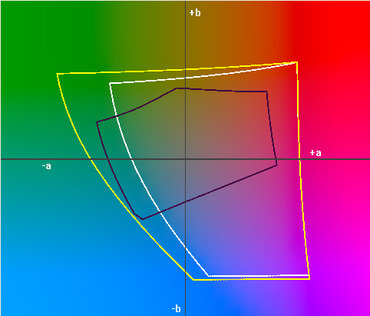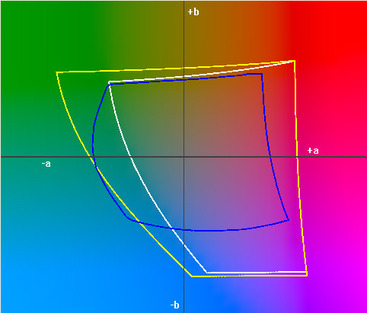Adobe RGB vs sRGB - what colors space to use?

The question has often been posted regarding the differences between Adobe RGB and sRGB. To better understand these two color spaces, lets try to see them visually.
The white diagram represents the sRGB color space. The yellow diagram represents the Adobe RGB color space. Notice that the Adobe RGB color space is much wider. There are more ranges of color, that can be found in the Adobe RGB color space than in sRGB. The advantage is more evident in the blue to green color ranges.
sRGB is the default color space of most digital devices from cameras to scanners to monitors. Although, some devices allow captures to be done using the Adobe RGB color space. This gives you the advantage of being able to capture a wider range (gamut) of color.
To be able to utilize this color advantage, you would have needed to capture your image using the Adobe RGB color space in your DSLR (if your camera is capable of doing so). Or you can achieve this by shooting RAW and converting to Adobe RGB upon post processing. It will not work if you captured an image in sRGB and then convert to Adobe RGB in photoshop. If the colors were not captured to begin with, converting to Adobe RGB will not create those missing colors.
Now the question is when do we use Adobe RGB and sRGB?
The general school of thought is to capture and edit in Adobe RGB, and if necessary, convert to sRGB. Yet, for practical purposes, you might not need to use Adobe RGB in certain situations.
1. If all your images are just to be shown on the web or to be displayed on the computer, Adobe RGB becomes an extra unecessary step. What you see on the web is limited by the color range displayed by monitors. sRGB is a color space based on typical monitors. Thus, if you want colors to be accurately represented, you would need them to be in sRGB. If ever you try to display an Adobe RGB image on the web, you will notice that the colors are very much off.
2. If you are not overly critical about color and will only be printing with Minilabs, then it might be practical to just work within the sRGB color space. Most minilabs are sRGB by default and cannot handle Adobe RGB images. If you try printing an adobe rgb image you will also end up with colors that are off as they will be interpreted as sRGB images.
The white diagram represents the sRGB color space. The yellow diagram represents the Adobe RGB color space. Notice that the Adobe RGB color space is much wider. There are more ranges of color, that can be found in the Adobe RGB color space than in sRGB. The advantage is more evident in the blue to green color ranges.
sRGB is the default color space of most digital devices from cameras to scanners to monitors. Although, some devices allow captures to be done using the Adobe RGB color space. This gives you the advantage of being able to capture a wider range (gamut) of color.
To be able to utilize this color advantage, you would have needed to capture your image using the Adobe RGB color space in your DSLR (if your camera is capable of doing so). Or you can achieve this by shooting RAW and converting to Adobe RGB upon post processing. It will not work if you captured an image in sRGB and then convert to Adobe RGB in photoshop. If the colors were not captured to begin with, converting to Adobe RGB will not create those missing colors.
Now the question is when do we use Adobe RGB and sRGB?
The general school of thought is to capture and edit in Adobe RGB, and if necessary, convert to sRGB. Yet, for practical purposes, you might not need to use Adobe RGB in certain situations.
1. If all your images are just to be shown on the web or to be displayed on the computer, Adobe RGB becomes an extra unecessary step. What you see on the web is limited by the color range displayed by monitors. sRGB is a color space based on typical monitors. Thus, if you want colors to be accurately represented, you would need them to be in sRGB. If ever you try to display an Adobe RGB image on the web, you will notice that the colors are very much off.
2. If you are not overly critical about color and will only be printing with Minilabs, then it might be practical to just work within the sRGB color space. Most minilabs are sRGB by default and cannot handle Adobe RGB images. If you try printing an adobe rgb image you will also end up with colors that are off as they will be interpreted as sRGB images.
Let's take a look at the colorspace of a Noritsu Printer, one of the most common among minilab printers.

The green diagram represents the range of colors a Noritsu Printer is capable of printing on Kodak Royal Silk paper. Take note that it is much smaller than the sRGB color space. Notice also that hardly any uniquely Adobe RGB colors are encompassed by the Noritsu's effective color range. Thus using Adobe RGB for a minilab print would in effect be useless as the color advantage cannot be utilized.
Take note also that since the Noritsu's color gamut is smaller than the sRGB color range, that means that there are many colors that can be captured and viewed on the monitor but cannot be printed. What happens is that the internal color management system of the printer finds a substitute color for these out of gamut colors. This is one important thing that we must take note of when printing our images. Some colors are not capable of being printed.
Using Adobe RGB is advantageous if you are printing with CMYK printers and high end photo printers. Let's take a look at the CMYK color space in relation to Adobe RGB and sRGB color spaces.

Although minilabs cannot take advantage of the wider color range of Adobe RGB, professional labs that use Professional printers can do so. Let's take a look at Kodak's top-of-the-line RP 50 LED printer.

SUMMARYUse sRGB when
1. photos will be used for the web 2. photo will be printed at minilabs 3. you are not critical about colors Use Adobe RGB when you are critical about colors and 1. you are printing with CMYK (printing press) 2. you are printing with inkjet printers 3. you are printing with a professional lab |